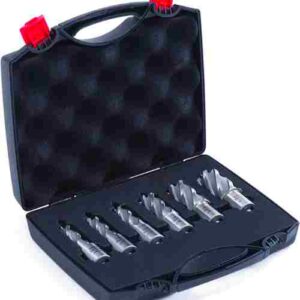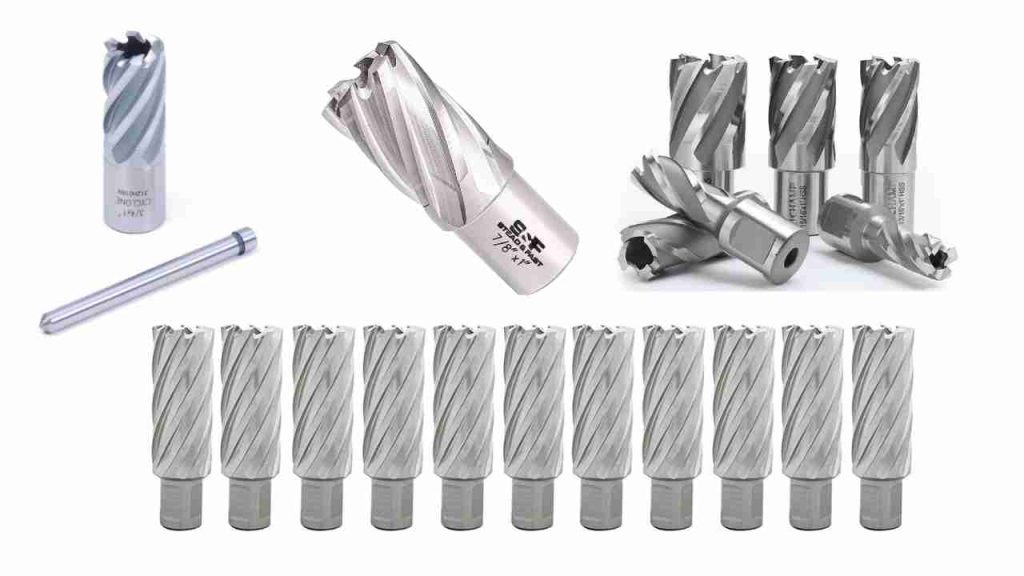Drill presses have long been the power tool for both professional and novice woodworkers and metalworkers. But have you ever wondered whether your beloved drill press has more to it than meets the eye?
In today’s article, we’ll look into the interesting world of annular cutters and see whether they may be used with your drill press to reach exceptional precision and speed. Whether a seasoned pro or a weekend warrior, you’ll discover how to take your hole-making game to the next level.
So, strap up and let’s get into the specifics of employing annular cutters in a drill press and how they might open up new possibilities for your projects!
 What is an annular cutter?
What is an annular cutter?
An annular cutter, also known as a core drill or hole saw, is a specialized cutting tool used to drill precise and accurate holes in various materials such as metal, wood, and plastic. The instrument is cylindrical and has cutting teeth on its inner and outer edges.
Unlike ordinary twist drills, annular cutters remove just the material around the outside of the hole, leaving behind a solid circular core. Its design minimizes the quantity of material that must be cut, resulting in quicker cutting rates, better hole quality, and less tool wear.
Annular cutters are extensively used in the metalworking, fabrication, and construction sectors to create clean and precise holes, such as bolt holes, pipe or conduit apertures, and large-diameter sheet metal holes.
They are available in various sizes, materials, and coatings to fit various applications and workpiece materials. High-speed steel (HSS), carbide-tipped, and cobalt alloys are all typical materials for annular cutters.
Can you use an annular cutter in drill press?
Yes, you can use an annular cutter in a drill press, but certain factors and modifications must be considered for a safe and successful operation. Annular cutters are designed for high-precision hole cutting and offer several benefits, such as increased accuracy, faster cutting speed, and reduced tool wear.
How to use an annular cutter in drill press?
When utilizing an annular cutter in a drill press, the following suggestions will help you reach peak performance and reap the most benefits:
- Choose the appropriate annular cutter: Choose an annular cutter with the correct diameter, depth, and material for the hole in your workpiece.
- Choose the proper arbor: Choose the correct arbor or adapter for your annular cutter and drill press spindle. Since most annular cutters use a Weldon shank, you’ll almost certainly require a Weldon shank adaptor.
- Install the annular cutter as follows: Remove the old drill chuck from the spindle of your drill press and replace it with the Weldon shank adapter. Put the annular cutter into the adapter and secure it in position as directed by the adapter.
- Set the proper RPM: For the suggested RPM for your annular cutter dependent on the material you’re dealing with, see the manufacturer’s specifications. Change the drill press speed as needed.
- Secure the workpiece: Use a sturdy vise or clamping system to securely hold it, ensuring it is level and properly aligned with the annular cutter.
- Mark the center of the hole: Use a center punch or a marker to mark the hole’s location on your workpiece.
(Optional) Drill a pilot hole first: Consider drilling a tiny one for better alignment and less stress on the annular cutter if you’re dealing with thicker materials or bigger hole sizes. - Use the following cutting fluid or coolant: Apply a cutting fluid or coolant to the annular cutter and workpiece for metal drilling to reduce friction, avoid overheating, and increase tool life.
- Align the annular cutter as follows: Reduce the spindle speed of the drill press until the annular cutter is above the indicated hole site (or pilot hole, if used). Check that the cutter is correctly aligned with the mark.
- Start drilling: To cut the hole with the annular cutter, turn on the drill press and slowly lower the spindle, using steady and constant pressure. Keep the feed rate steady throughout the drilling operation.
- Remove chips and add additional cutting fluid: Stop the drilling operation regularly to remove any chips or debris from the hole, and add more cutting fluid as required.
- Fill in the blanks: Drill to the necessary depth with the annular cutter, then gently elevate the spindle to remove the cutter from the hole.
- Clean and examine the hole: Remove any residual chips or debris from the hole and examine it for accuracy and quality. Deburr the hole as needed using a deburring tool or file.
- Turn off the power and tidy up: Remove the workpiece, annular cutter, and drill press from the drill press and clean any residual cutting fluid or debris.
Frequently Asked Questions (FAQs)
Q: Do I need any special equipment to use an annular cutter in my drill press?
A: Yes, you will need a compatible arbor or adapter to use an annular cutter in your drill press. Most annular cutters use a Weldon shank, so you may require a Weldon shank adapter.
Q: Can I use an annular cutter for woodworking applications in a drill press?
A: Yes, annular cutters can be used for woodworking projects with a drill press. Make sure you select the appropriate annular cutter material and size for the task at hand.
Q: How do I determine the correct RPM for my annular cutter and drill press?
A: Consult the manufacturer’s specifications for the recommended RPM for your annular cutter based on the material being drilled. Adjust the speed of your drill press accordingly.
Q: How do I know when to add more cutting fluid during the drilling process?
A: Frequently check your annular cutter and workpiece while drilling, and add more cutting fluid as needed to keep the cutting edges lubricated and to prevent overhe ating.
Q: How do I prevent my drill press from getting damaged when using an annular cutter?
A: To prevent damage, ensure proper installation of the annular cutter and adapter, secure the workpiece adequately, and maintain steady feed pressure while drilling. Additionally, use the appropriate RPM setting and cutting fluid to minimize strain on the drill press.
Q: Can annular cutters be sharpened or do they need to be replaced when dull?
A: Some types of annular cutters can be re-sharpened, while others may need to be replaced when they become dull. Consult the manufacturer’s guidelines for your specific annular cutter to determine the best course of action.
Q: Can I use an annular cutter on any type of drill press, or do I need a specific model?
A: Annular cutters can be used on most drill presses that have the capability to accept the appropriate arbor or adapter. Check your drill press’s specifications and compatibility before attempting to use an annular cutter. If unsure, consult the manufacturer for guidance.
Q: Are there any safety precautions I should keep in mind when using an annular cutter in a drill press?
A: Always wear proper safety gear, including safety glasses and hearing protection. Secure the workpiece with a clamping system or vise to prevent movement during drilling. Ensure that the annular cutter and drill press are correctly set up, and maintain a steady feed rate to prevent any potential injuries or damage to the tools.
Final words:
Using an annular cutter in a drill press is feasible, which opens up a world of accuracy and efficiency for your tasks. You can unleash the full power of your drill press and enhance your hole-making game by taking the required precautions, choosing the correct equipment, and following our advice for the best performance.
Always remember, as with any power tool, that safety comes first. Thus, whether you’re a seasoned expert or a determined do-it-yourselfer, don’t be afraid to experiment with this potent mix and uncover new possibilities for your woodworking and metalworking projects.
 Now, drill confidently, knowing that your trusty drill press and annular cutter have your back!
Now, drill confidently, knowing that your trusty drill press and annular cutter have your back!
- Where are WEN drill presses made? - April 2, 2023
- Where are Rikon drill presses made? - April 1, 2023
- Where are Powermatic drill presses made? - April 1, 2023






